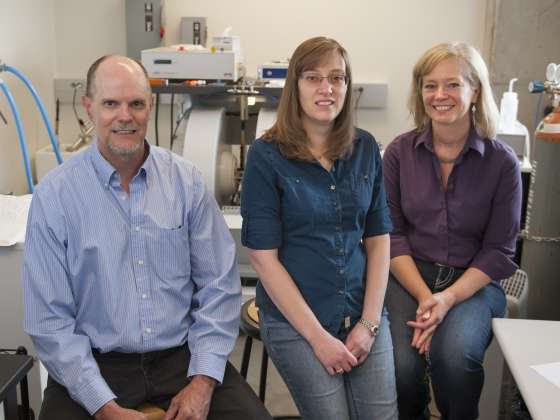Scientists publish new findings on vital biochemical process

Two Montana State University professors and their colleagues have made an important discovery that advances the understanding of a biochemical process underpinning nearly all known life.
Will and Joan Broderick, a husband-wife team in the Department of Chemistry and Biochemistry in MSU's College of Letters and Science, along with others in the MSU Broderick research group and collaborators at Northwestern University, published their findings in the May 13 issue of Science.
The paper pinpoints the workings of a biological molecule catalyst, or enzyme, in a family known as "radical SAMs."
Radical SAMs are the largest family of enzymes in nature and are related to more than 100,000 proteins found in bacteria, plants, animals and other life forms. They are responsible for key biological functions, including human immune defense and the synthesis of components of DNA.
"Life as we know it wouldn't exist without radical SAMs," said Will Broderick.
SAM is an acronym for the S-adenosylmethionine molecule that is common to the family. Radicals are highly reactive atoms or molecules, known in their "free," or uncontrolled, state to be physiologically damaging. Radical SAMs harness radicals to perform beneficial, complex biochemical reactions.
Radicals are like the "sledgehammers" of biochemistry, said Will Broderick, and radical SAM enzymes control and use the radicals "with the precision of tweezers."
"Otherwise, it's like swinging the sledgehammer in a china shop—not pretty," added Joan Broderick.
Until now, the precise way that SAMs harness radicals has eluded scientists.
The research team reacted samples of the selected radical SAM with another protein, then instantly froze each sample with liquid nitrogen. While advancing the reactions with incrementally warming temperatures, they used spectroscopy to observe the rearranging molecules.
That allowed the researchers to identify a unique, organo-metallic molecule as a key intermediate in the SAM's handling of the radical. Such behavior has been observed in few other cases, including the metabolism of vitamin B12, an essential nutrient for human health.
Because radical SAMs share a common set of characteristics and are so widespread in nature, the findings "suggest that there's a unified way that organisms control these radical reactions," said Joan Broderick.
"It takes it from a few known examples to everywhere in biology," she said.
The discovery also has implications for understanding the evolution of life, because radical SAMs are thought to be among the most ancient enzymes of life.
"Early on in the emergence of life, this type of chemistry could have been going on to allow some key transformations to happen," she said.
According to Mary Cloninger, head of the MSU chemistry and biochemistry department, "these enzymes are a hot topic right now. To have someone at Montana State discover a new intermediate in a reaction process that is the focus of research efforts across the globe is incredibly exciting."
For Joan Broderick, who is MSU's first Women in Science Distinguished Professor, publishing the findings in "Science" is the culmination of more than 20 years of work in this young research field.
Co-authors include recent MSU doctoral graduates Krista Shisler and Rachel Hutcheson; Kaitlin Duschene, former research technician in the Broderick research group; and Masaki Horitani, Amy Marts and Brian Hoffman of Northwestern University. The research was supported in part by the National Institutes of Health.
Will Broderick said the next step is to confirm whether other radical SAMs use a similar intermediate reaction. If they do, he said it would mean that most life on Earth shares an intricate biochemical process nearly as integral to biology as DNA.
More information: M. Horitani et al. Radical SAM catalysis via an organometallic intermediate with an Fe-[5'-C]-deoxyadenosyl bond, Science (2016). DOI: 10.1126/science.aaf5327
Journal information: Science
Provided by Montana State University





















